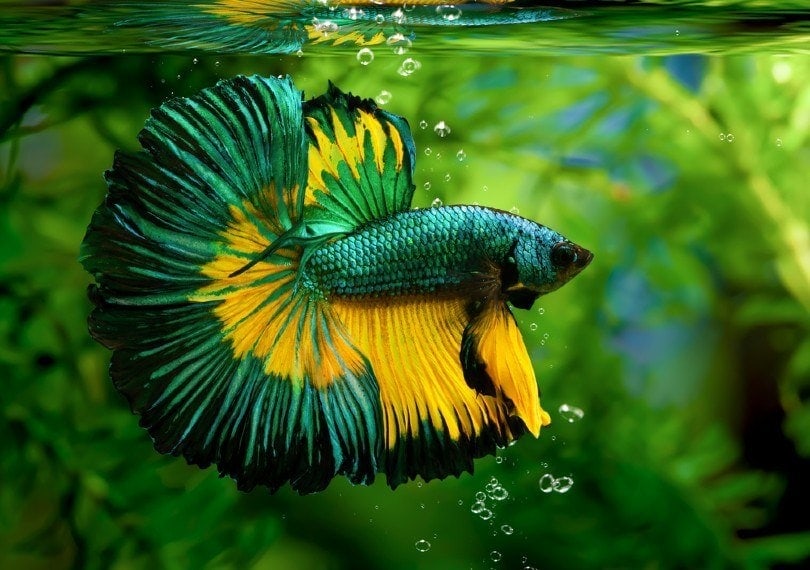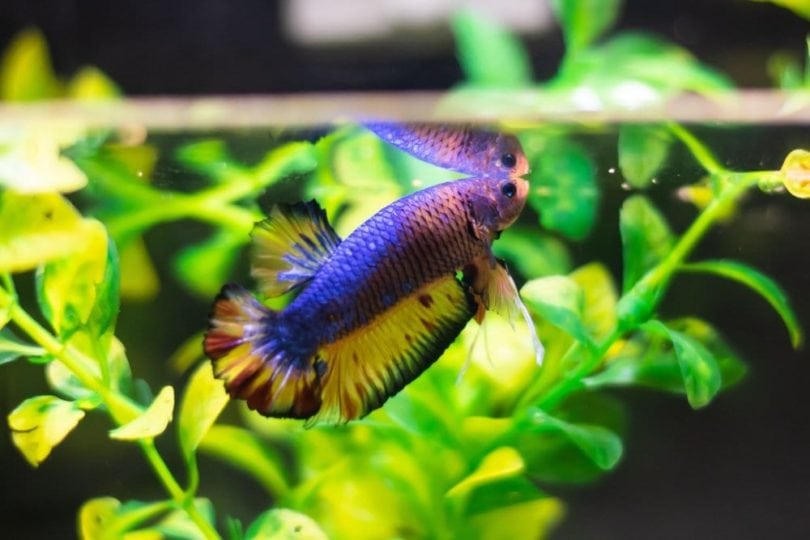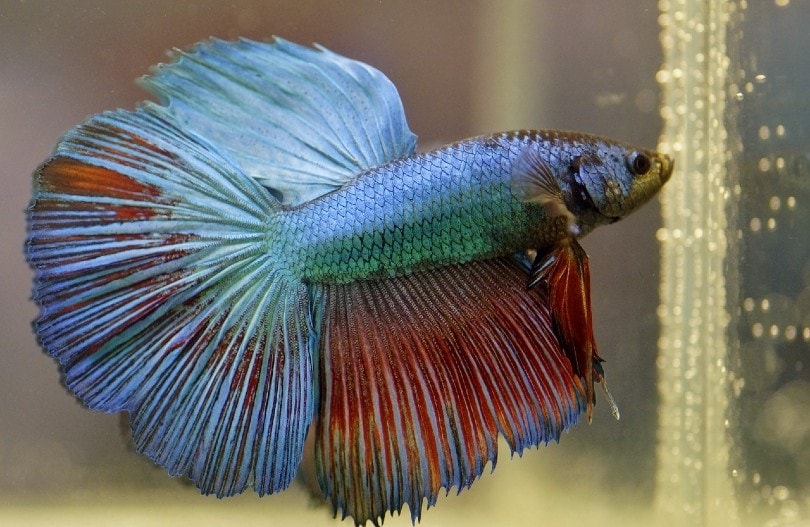9 Myths & Misconceptions About Betta Fish: Vet-Approved Info

Updated on
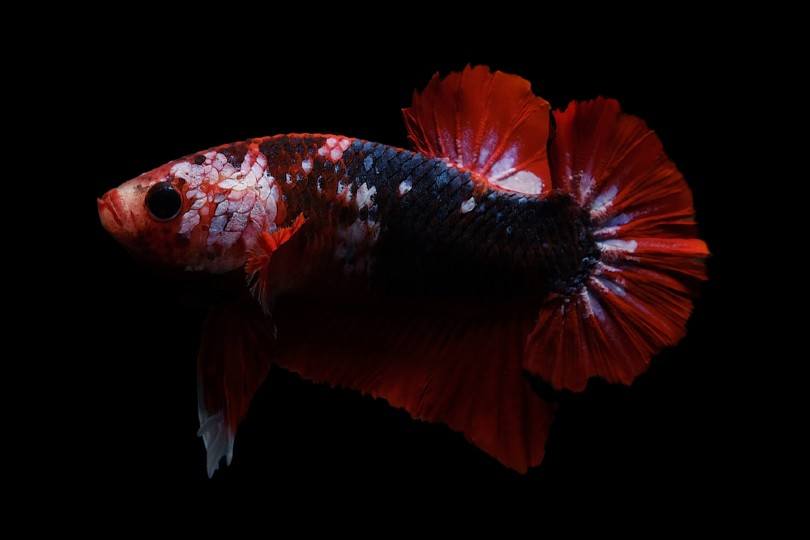
Betta fish are one of the most popular fish species in the aquarium trade. These fish are beautiful, and with the correct setup, they are relatively easy to care for. They’re known for their interesting habits and long, flowing fins. There are a lot of misconceptions and myths surrounding Bettas, however.
Due to inaccurate information, many Betta fish don’t live long lives. They are often kept in inappropriate conditions and fed a diet that isn’t appropriate for them. To help improve the care of Bettas across the world, it’s essential to examine the myths and misconceptions surrounding them.
The 9 Common Myths & Misconceptions About Betta Fish
1. They Can Thrive in a Vase
There is a prevalent misconception about Bettas that they can live in vases, and people believe that they can survive by eating the roots of the plant in the vase. Not only is this incorrect, but it’s also downright cruel.
A vase is an inappropriate environment for a Betta for multiple reasons, but the biggest issue with this setup is the belief that Bettas can live off of plant roots. Bettas are carnivores, so they cannot survive off of any plant matter for a long time, and they will not thrive on a plant-based diet in the short term. Like all living things, Bettas require environments similar to their natural habitat to give them the healthiest and happiest life.

2. They Don’t Require a Heated Environment
While many fish don’t require a heated tank, such as Goldfish and Weather Loaches, Bettas are fully tropical fish that require warm water temperatures. The ideal tank temperature range for a Betta fish is between 81°F and 84°F. Their specific temperature requirement is 82.4°F (28°C). A Betta’s immune system will suffer in cooler water temperatures, leading to an increased risk of illness and premature death.
The best way to ensure that your Betta is kept warm at all times is to place their aquarium in a room that’s consistently slightly cooler than their optimal temperature and to use an aquarium heater to reach the desired temperature. For example, housing them in a room that’s 80–81°F and setting the water heater to 82–83°F ensures that your Betta is in an appropriate environment. Water heaters do not work if the ambient temperature exceeds their setting. Although Bettas can tolerate slightly higher temperatures relatively well, the other inhabitants in your aquarium might not appreciate the fluctuations as much. It’s also advised to use a room thermometer to ensure that your Betta’s room isn’t too warm or too cold.
Since a water heater is vital for your Betta’s welfare, ensure that you follow all of the manufacturer’s instructions while using it. For example, most water heaters only work when submerged, so you should turn off the device before changing your Betta’s water.
3. They Can Eat Any Fish Food
Betta fish are carnivorous fish that require a high protein content in their diet. As mentioned, they cannot thrive or survive for the long term on a plant-based diet. Even plant-based diets high in protein don’t contain all the amino acids and nutrients required for a Betta to survive.
For example, if you’re feeding your Betta the same food that your Goldfish eats, one of your fish is receiving an inappropriate diet. Many aquarium fish are omnivorous, so Goldfish foods are typically not appropriate for carnivorous fish.
A high-quality diet is a great way to ensure that your Betta stays healthy. There are several Betta foods on the market, but the prevailing advice is to buy a high-quality floating or slow-sinking pellet food with a protein rating between 35% and 43%. Foods with a protein rating under 33.4% or over 43.4% are not recommended for Bettas (unless they are being conditioned for breeding purposes, in this case they can be fed food higher in protein). The food should also have good-quality fats derived from an aquatic source (usually an invertebrate or something of fish origin). It should be the top ingredient in the pellet.
No pellet is considered a complete diet for Bettas, so you should also give your Betta a variety of treats consisting of high-protein offerings like tubifex worms, daphnia, rotifers (for newborn fish), brine shrimp, and frozen and freeze-dried carnivorous fish foods.
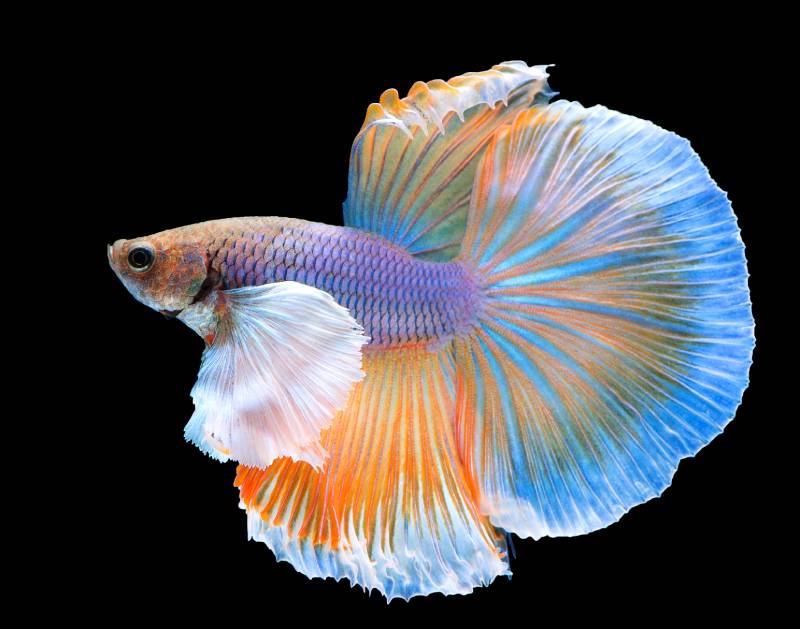
4. They Like Small Environments
There is a misconception surrounding the preferred size of a tank for a Betta fish. Due to their relatively small size, they’ve become known as an excellent option for small aquariums. Some people keep their Bettas in 3-gallon tanks or smaller, and many of the vase “tanks” are less than 1 gallon. The ideal tank size for a Betta fish is at least 5 gallons, and some people prefer tanks up to 10 gallons for a single Betta.
A larger tank gives your Betta plenty of space to explore and exercise and enough room for you to provide enrichment like plants and hammocks. The smaller the tank, the more maintenance it will require. Smaller tanks will develop a buildup of waste products faster than larger tanks, even with only one fish.
5. They Don’t Require Filtration
Piggybacking off of the idea of Bettas happily living in a fully enclosed environment, many people believe that their Betta doesn’t require a tank with filtration because the plant roots will create oxygen exchange and remove waste products from the water. While plants can help oxygenate a tank and remove nitrates and other waste products, they cannot be used as the only form of filtration.
Betta fish do not need strong currents in their tanks, so some people avoid filtration. Too much filtration can lead to physical exhaustion, stress, and illness for a Betta fish. It is vital for the health and well-being of a Betta that they have a tank with adequate filtration for the size of the tank and the number of animals. Sometimes, a sponge or internal filter may be an appropriate option to filter the tank without creating a strong current. Hang-on-back and canister filters are good options if you can control the flow.
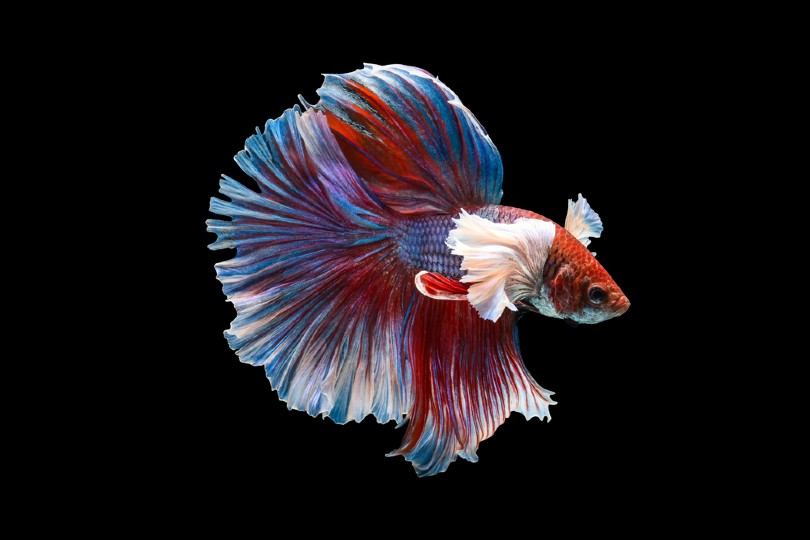
6. They Can’t Have Tankmates
Bettas are known for being aggressive fish that can’t play nice with others, leading many to believe that no tankmates are appropriate for a Betta. But if you’re interested in having a couple of fish in your tank, you’re in luck because some Bettas can be kept in tanks with other fish and animals.
Please note that the aggression level of Bettas is often unpredictable and may involve a genetic component. Some Bettas may be more aggressive than others. However, given the Betta’s slow swim speed and relative frailty, when opting for a community setup, you should ensure that the Betta’s tank mates aren’t aggressive, as they can easily pick on the Betta, and a Betta is rarely nimble enough to pose a serious threat to compatible tank mates.
Male Bettas are more territorial than females and tend to be extra aggressive toward other male Bettas. They can be bullies toward females, so it’s generally not recommended to keep male and female Bettas together except when supervised during breeding attempts.
Examples of fish that can make suitable tankmates for a Betta include Harlequin Rasboras, Emperor Tetras, Oto Catfish, Apple snails, Zebra Danios, Leopard Danios, and Rummynose Tetras.
Please be mindful of the following:
- While Neon Tetras are considered compatible tank mates, they sometimes carry a disease known as Neon Tetra Disease. This disease has no cure and while not exclusive to Neon Tetras, it is most commonly found in them because they are often mass bred in less than ideal, stressful conditions.
- Although fancy guppies can sometimes be housed with Bettas, many Bettas tend to inadvertently confuse their colors and flowing fins as those of a rival and resort to attacking them. Fancy guppies aren’t prolific swimmers and can easily be bullied by an aggressive Betta.
- Many schooling tropical fish that are peaceful and small are excellent tankmates for a Betta. However, these fish should always be part of a school, with at least six to seven other fish of their species. If they are not a school, these otherwise peaceful fish may resort to erratic behavior, including biting your Betta, due to the stress associated with not being a school.
- Some relatively peaceful tankmates can turn aggressive if they decide to spawn. An example of such a fish is the German Ram Cichlid.
- While usually peaceful, Corydoras possess a small stinger spine near each eye. If startled, they may quickly use the spine to poke at a perceived threat, injecting a toxin that may kill a fish. This toxin is fairly harmless for humans (though you may feel the sting).
7. They Get Lonely
While some Bettas can be kept in tanks with tankmates, tankmates aren’t a necessity for the happiness of your Betta fish. Bettas are not shoaling fish, so they do not naturally live in groups or schools. A singular Betta can live a perfectly happy life without tankmates. Females are somewhat more flexible than males, which is what makes them suitable for sororities and some community tanks. This doesn’t mean they need to be kept in sororities, however.
Both male and female Bettas can live long, happy lives in a tank by themselves. There are ways to provide enrichment to a fish without introducing a tankmate. In fact, an inappropriate tankmate can cause more stress than companionship, not to mention increasing the waste products in the tank.
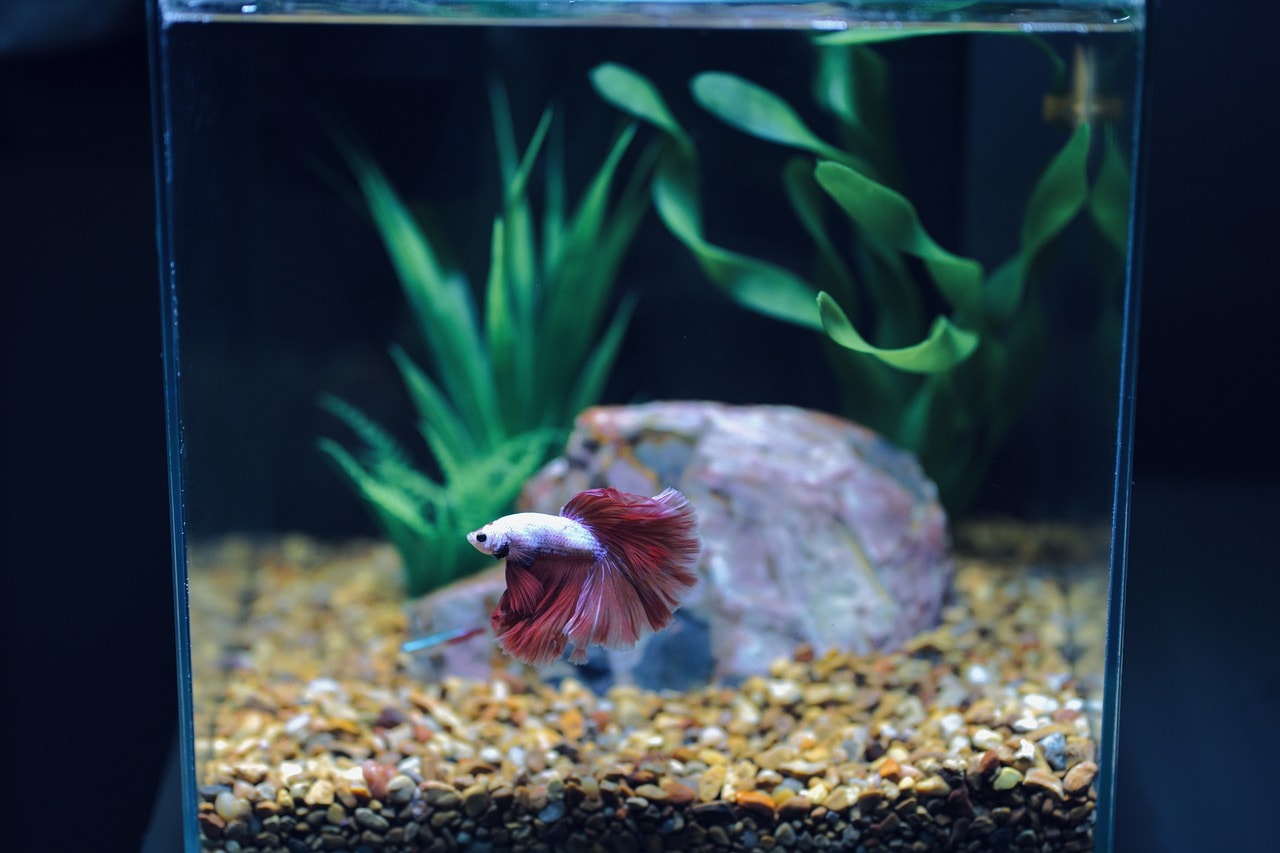
8. They Can Die From Flaring
Male Betta fish can be seen flaring their gills out wide, sometimes in response to the presence of another fish and sometimes when seeing a reflection of themselves. On occasion, females will also flare at males and females, but this is less common. Some people believe that the act of flaring can kill a fish, either from suffocation or stress.
Even though a Betta flares their gills, they won’t allow themselves to suffocate. The act of flaring is to intimidate a perceived threat. In many instances, it serves a defensive purpose too. If a male flares at an opponent and the opponent retreats, it may prevent a physical confrontation, sparing both the fish from potential injury.
That said, long-term, uncontrolled and consistent flaring indicates stress, and sustained exposure to stressful situations can lead to the death of a fish. This sometimes happens if a Betta is placed close to a mirror or if they can consistently see their reflection in the glass (they may confuse their reflection with another Betta).
In a roundabout way, flaring could kill a Betta, but only if allowed in the long term or if the fish is already ill or stressed. A weakened fish can die from the stress of an encounter that leads to flaring, but your Betta would likely be extremely ill and in deplorable shape for this to occur so suddenly. Although short-term flaring is unlikely to lead to the death of your Betta, it should be avoided under most circumstances on a long-term basis.
Interestingly, some breeders like to exercise their male Bettas by temporarily making them flare, with the justification that the fish also flares their fins and tail in the process, promoting blood flow and therefore, better growth of these parts, thus making them more vibrant. However, this theory remains mostly anecdotal, and there have been no studies that definitively prove this perceived benefit.
9. They’re Stupid
People generally think of fish as stupid animals without the capacity for memory and learning. Science has begun to show that this is untrue for many fish species, including Bettas. Betta fish show the ability to recognize patterns, including human faces. They may be able to identify specific sounds and vibrations created by certain people, allowing them to know who is approaching their tank before seeing them.
They are known to bond with people, but this is often overlooked since it is not the same type of bond that people share with more “traditional” pets like cats and dogs. Fish have slightly different brain structures than mammals, and they rely more heavily on their primitive brain functions and reflexes, as opposed to emotion and skills. Bettas can identify people, sometimes even months or years after last seeing them, and they can learn to “beg” to get food.

 Conclusion
Conclusion
Bettas are lovely fish that can live up to 5 years in captivity with appropriate care. Caring for a Betta requires thoroughly educating yourself on the needs of the fish before bringing one home. Bettas are often purchased on a whim when their bright colors and long fins are spotted in the pet store.
These fish should be treated with kindness and respect, and bringing a Betta fish home is a commitment to providing exemplary care to your fish and giving them the best chance at a long, healthy, happy life.
In this article, we’ve debunked some of the common myths involving these fish. We hope that this information has helped you better understand these amazing animals a little better.
Featured Image Credit: Shutterman70, Shutterstock


 Conclusion
Conclusion